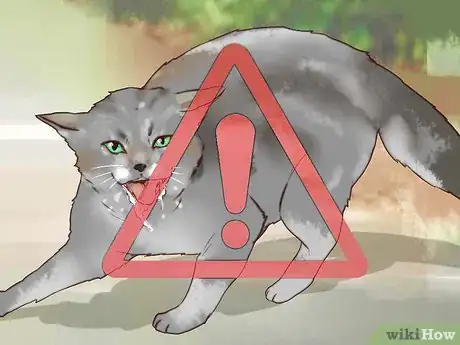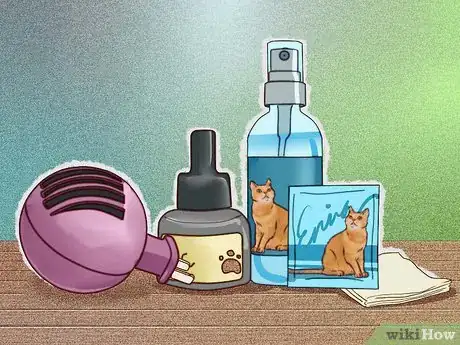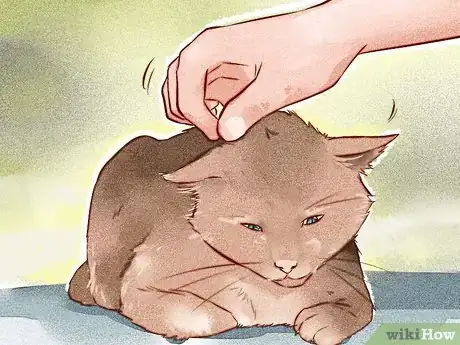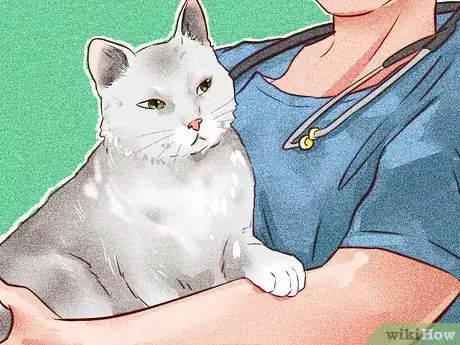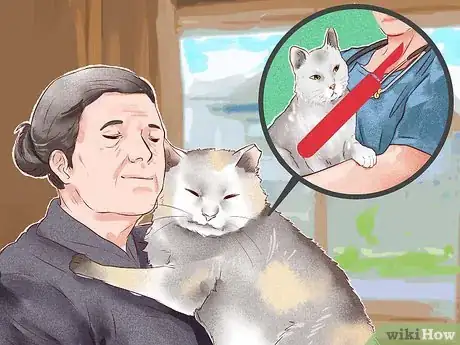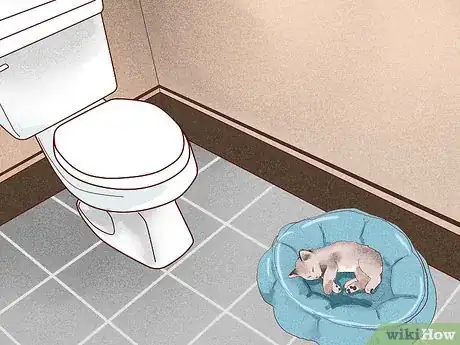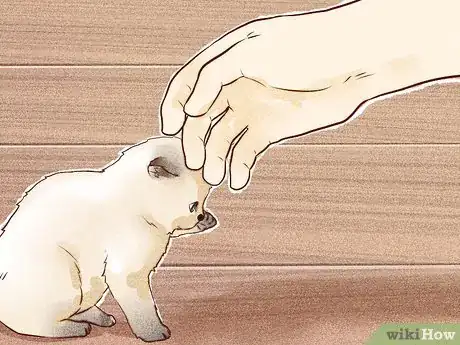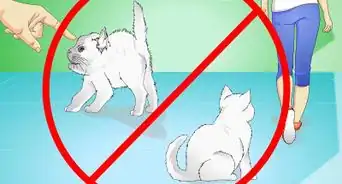This article was co-authored by Pippa Elliott, MRCVS. Dr. Elliott, BVMS, MRCVS is a veterinarian with over 30 years of experience in veterinary surgery and companion animal practice. She graduated from the University of Glasgow in 1987 with a degree in veterinary medicine and surgery. She has worked at the same animal clinic in her hometown for over 20 years.
There are 16 references cited in this article, which can be found at the bottom of the page.
wikiHow marks an article as reader-approved once it receives enough positive feedback. In this case, 81% of readers who voted found the article helpful, earning it our reader-approved status.
This article has been viewed 187,385 times.
Taming a feral cat takes time, knowledge and patience coupled with extreme caution. A feral cat is a domesticated cat that has reverted to wild and is not socialized to humans. If the cat or kitten appears healthy and you wish to attempt taming it, keep in mind these cats will be scared of you and are likely to bite. However, if you find or are given a fearful or scared stray cat or kitten that tolerates some human interaction without biting, you can try to tame it to make it an acceptable cat. You may never make an indoor cat out of it, but it may become a good outdoor kitty that tolerates you.[1] Sometimes all that is needed is plenty of patience to turn a scared kitty into a marvelous pet. Your first goal should be to make it comfortable around you. Then the cat should be taken for a very important veterinary visit to make sure it is healthy.
Steps
Observing the Cat's Nature
-
1Get to know the cat's personality. Observe the cat for a few days. This way, you can determine its nature, especially when humans come close. Is the cat afraid or scared of people? Is it angry?
- If you think they may be dangerous you shouldn't try handling them. Instead, call animal control or a human society who will be able to professionally capture and handle the cat if you think they pose a danger.
-
2Observe the cat's body language for cues. Cats communicate their feelings with body language that can be rather obvious.[2] For example:
- An angry or upset cat will have ears that are flattened back, dilated pupils, a tail which is switching back and forth, an arched back, and fur standing on end. The cat will typically be growling. This is a sign to back off.
- If it hasn't run away, a scared cat will typically lay flat or have its tail between its legs. Proceed with caution in trying to tame these cats.
- In contrast, a contented and relaxed cat's ears will be forward and alert, and its tail will be straight up in the air. Its fur will be flat (not standing on end), and the cat may even stretch, lay down, and roll onto its back. [3]
Advertisement -
3Observe the cat's general health. While you will not be close to the cat, you will be able to observe its overall health from afar. [4] Check to see if it looks skinny or bony. It may be hungry. Look at its fur to see if it looks healthy, or if it looks matted, patchy, bald, or otherwise unhealthy. See if the cat has any other obvious issues, such as limping, cuts, sores, or other problems. [5]
-
4Stay away from cats with suspected rabies. Feral cats and kittens are generally unvaccinated and carry a slight risk for carrying the deadly rabies virus. While very uncommon, rabies in cats can occur primarily in outdoor, unvaccinated cats and kittens. The symptoms of rabies can vary and may take months to develop after a cat or kitten was exposed to the virus.
- Classic signs of rabies in cats and kittens include an ill cat (lethargic, not eating, weakness) and/or changes in behavior (aggressive, restless, disoriented, paralysis, seizures).[6]
- If you encounter a feral cat with these symptoms, call animal control and do not attempt to handle the cat or kitten.
Letting the Cat Adjust to Your Presence
-
1Introduce the cat to your voice. If the cat seems amenable to taming, your next step is to get them used to you and your voice. Sit near them and talk to them in a soft, gentle voice.[7]
-
2Set out dry or wet food for the cat. As you continue talking to the cat, set out some food for it to nibble. [8] Try this for about three days. In the meantime, don't try approaching it.
- After three days, look for positive body language to determine if the cat seems comfortable with your presence. A content cat will prick its ears forward, hold its tail up and possibly arch its back. Its fur will be flat and it may even purr.
-
3Try approaching the cat with food. Use a spoonful of wet cat food or canned tuna fish and hold it out as you approach it. Call its name or say, “Kitty.” If the cat hisses at you, this can mean that the cat is just scared and it needs more time to get comfortable in your presence. Take your time letting the cat feel comfortable eating dry food around you.
-
4Watch for signs of aggression. If the cat makes any signs of aggression, such as lunging or growling, this cat needs more time to get used to your presence. You may also reconsider if you should call animal control.
-
5Use a cat pheromone product. If you need help making the cat feel more welcomed, you might try a cat pheromone product. These substances work by imitating cat pheromones that can calm a cat via the scent of the pheromones.[9] There are sprays you can use to spritz the area around the cat. But be aware that the spray sound may upset or scare the cat.
- There are also pheromone wipes that can be used to wipe a given area. You might even try a diffuser option if the cat is in an enclosed area.
-
6Pet the cat with a spoon. Get a long wooden cooking spoon or spatula. Wrap some soft cloth around it. Fleece works nicely. Slowly put a spoonful of food out close enough to you so you can reach out without startling the cat. While it is eating, slowly reach out with the spoon and pet them with it. It may take a few tries and a few days before the cat is comfortable with this process.
- If the cat runs away, don't run after it. Save the petting for later.
Making Contact with the Cat
-
1Wear protective clothing. Until you are able to get the cat to the veterinarian for a checkup, it is best to handle the cat while you wear protective clothing. Wear thick gloves, a long-sleeved shirt and long pants to minimize the chance of getting scratched or bitten.
-
2Use your hand to pet the cat. After you've been petting the cat with a spoon for a while, try sneaking your hand under the spoon and petting the cat. Only pet the cat's shoulders and head.
- Don't get anywhere near its underside. A cat will be very defensive if it feels threatened. Only when your cat fully trusts you will you be able to pet its belly.[10]
-
3Try picking up the cat. Use a towel or blanket to pick up the cat. Do this after you've pet the cat a few times. Choose a time when the cat seems calm and relaxed.
- It can take a long time to get to this stage. It really depends on the cat. Some cats will never be truly tamed enough to pick up.
- If the cat struggles when you hold it, let it go. You may end up getting scratched or bitten. You might also undo all your hard work getting to this point.
Visiting the Vet with the Cat
-
1Get the cat accustomed to a carrier. The cat will need to be placed in a carrier so that it can be transported to the vet for an important health checkup. You need to allow time for the cat to get accustomed to the carrier.
- Leave the carrier open in your house so that the cat can explore it on his own.
- Try placing his food dish in front of the carrier, so he will be more likely to investigate.[11]
- Move the food to inside the carrier so that the cat will step inside.
-
2Take the cat to the vet. If you are able to eventually handle the cat, bring it to the veterinarian as soon as possible. You can get its health evaluated, get vaccinated, and have any other treatments that it may require.
- Vaccinate the cat in order to protect it from various diseases, such as feline leukemia and others. Ask your vet which vaccines are recommended.
-
3Ask the vet about flea and worming treatments. Since the cat has likely been outside its entire life, it will need to be treated for and protected against fleas and worms.[12] Your vet can apply flea and worming treatments on the spot, or she may give you a recommendation of flea and worming treatments you can administer at home.
-
4Get the cat spayed or neutered. One of the best ways you can help is to have the cat spayed (female) or neutered (male) to prevent the birth of feral kittens. The vet will tip its ear, which is a painless procedure that is administered when the cat is under anesthesia. The very tip of the ear will be trimmed off. This serves as a sign that the cat has been spayed or neutered.[13]
Socializing a Feral Kitten
-
1Try to tame the kitten between ages four and eight weeks old. When a kitten is in the weaning stage, it will respond better to taming. It is gaining independence from its mother during this stage. Once a kitten is socialized, it will be suitable for adoption.[14]
-
2Give the kitten a place to feel secure. When you're not actively working on socializing it, make sure the kitten has a small, quiet room where it can retreat and relax. This might be a bathroom or a spare bedroom.[15]
- Leave a nightlight on overnight so that the room is never totally dark.
-
3Choose a suitable location. It is helpful to increase the kitten's exposure to humans by working with it in an area with human activity. You might try an area of your yard where other people are working or playing. Or, you might try an area in your house. [16]
-
4Get on the same level as the kitten. Don't tower over the kitten by standing next to it. Sit down on the floor or ground with the kitten.
-
5Give the kitten some wet cat food. As long as the kitten is healthy, you can use food as a way to socialize it. This way, you can entice it to approach you because it's hungry and wants to eat the food you've got. Sit down near the kitten as it is eating.
-
6Let the kitten lick food from your finger. After the kitten has become accustomed to having you nearby when it's eating, offer it a taste of food from your hand. You can either use wet cat food or baby food (try a beef or chicken flavored baby food).
- A kitten may try to gulp down food rather than lick it, since this is the natural way for it to eat. It may try to gently bite your finger as you're feeding it.
-
7Start petting the kitten. When the kitten is hungry and is eagerly eating, try gently petting it. Start by petting the head and shoulders only.
- If it runs away, go back to the previous step for a longer period of time.
-
8Transition to petting without food. After the kitten has gotten used to your presence and touch, you need to remove food from the equation. This will ensure that the kitten will still enjoy petting even if food is not offered. Try a petting session after the kitten has eaten and is full.
-
9Slowly introduce the cat to other people. If you are taming a cat for adoption, you'll need to make sure the cat is socialized to other people besides you. [19]
- Start allowing one person at a time spend moments with the kitten. These people should also try feeding the kitten first with a dish, then with their finger. The kitten will get used to their voices, scents and actions.
Expert Q&A
Did you know you can get expert answers for this article?
Unlock expert answers by supporting wikiHow
-
QuestionMy house cat allows me to pet her when I have food, but otherwise runs from me. What can I do?
 Pippa Elliott, MRCVSDr. Elliott, BVMS, MRCVS is a veterinarian with over 30 years of experience in veterinary surgery and companion animal practice. She graduated from the University of Glasgow in 1987 with a degree in veterinary medicine and surgery. She has worked at the same animal clinic in her hometown for over 20 years.
Pippa Elliott, MRCVSDr. Elliott, BVMS, MRCVS is a veterinarian with over 30 years of experience in veterinary surgery and companion animal practice. She graduated from the University of Glasgow in 1987 with a degree in veterinary medicine and surgery. She has worked at the same animal clinic in her hometown for over 20 years.
Veterinarian Try and make yourself as unthreatening to the cat as possible. Lie on the floor and avoid staring at her directly. Have a few treats in a hand and toss them near her, so she links you to nice things. Lie like this watching TV and eventually she will start to accept your presence and become more friendly.
Try and make yourself as unthreatening to the cat as possible. Lie on the floor and avoid staring at her directly. Have a few treats in a hand and toss them near her, so she links you to nice things. Lie like this watching TV and eventually she will start to accept your presence and become more friendly.
Warnings
- If the cat acts aggressive, back off for a while.⧼thumbs_response⧽
- Only people who are trained in dealing with feral cats should attempt to handle these animals.⧼thumbs_response⧽
- If you get bitten by a cat (feral or pet), see your doctor to have the bite treated. Carefully monitor cat scratches to make sure they do not become infected. [21]⧼thumbs_response⧽
References
- ↑ Alley Cat Allies. http://www.alleycat.org/page.aspx?pid=434
- ↑ http://www.humanesociety.org/animals/cats/tips/cat_communication.html
- ↑ http://pets.webmd.com/cats/features/cat-body-language
- ↑ http://www.aspca.org/pet-care/virtual-pet-behaviorist/cat-behavior/stray-and-feral-cats
- ↑ http://www.alleycat.org/page.aspx?pid=297
- ↑ http://www.humanesociety.org/animals/cats/tips/cat_communication.html
- ↑ http://messybeast.com/feralkit.htm
- ↑ http://www.aspca.org/pet-care/virtual-pet-behaviorist/cat-behavior/stray-and-feral-cats
- ↑ http://pets.webmd.com/features/pet-pheromone-products-for-behavior-problems
- ↑ http://messybeast.com/feralkit.htm
- ↑ https://www.aspca.org/pet-care/virtual-pet-behaviorist/cat-behavior/teaching-your-cat-ride-carrier
- ↑ http://www.alleycat.org/page.aspx?pid=297
- ↑ http://www.urbancatleague.org/FeralFAQ
- ↑ http://www.nycferalcat.org/info-kittenssoc.htm
- ↑ https://feralcatcaretakers.org/wp-content/uploads/2020/03/12.-Third-Class-How-To-Domesticate-And-Care-For-Feral-Or-Rescued-Kittens.pdf
- ↑ http://www.urbancatleague.org/TamingFerals
- ↑ http://www.urbancatleague.org/TamingFerals
- ↑ http://www.urbancatleague.org/TamingFerals
- ↑ http://www.urbancatleague.org/TamingFerals
- ↑ http://messybeast.com/feralkit.htm
- ↑ Animal Bite-associated Infections. Microbiology and Treatment. Nicole Thomas and Itzhak Brook. Expert Rev Anti Infect Ther. 2011;9(2):215-226.
- The Stray Cat Handbook. Tamara Kreuz. Wiley, Dec 15, 1999.
About This Article
To tame a cat, speak to it softly so it can get used to your voice. While you're talking, set out dry or wet food for your cat in a bowl. You should also wait a day or 2 before trying to pet your cat so it has time to get used to you. When you try to pet it, focus on touching its shoulders or neck first. If your cat is reluctant to approach you, you could use a pheromone product, like wipes or a spray, which will help calm your cat down and make it feel safe around you. For tips on how to prepare a cat to go to the vet for a checkup and how to socialize a feral kitten, keep reading!



